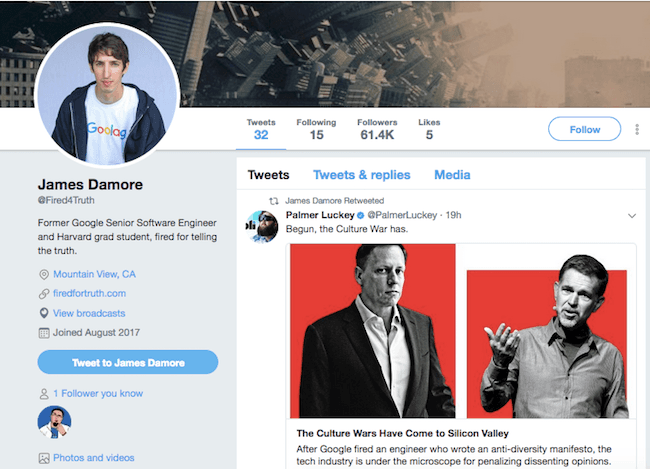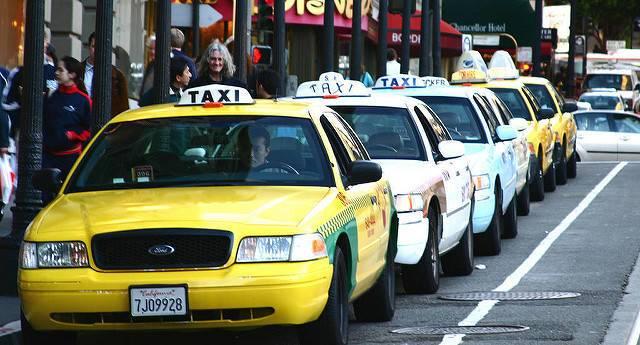Google's Most Famous Ex-Employee Derides Cult of Corporate Social Responsibility


When does corporate social responsibility cross the line from good business sense to cult-like social enforcement? That is the latest in a series of questions bubbling to the surface in the days since former Google software engineer James Damore posted an incendiary 10-page critique of the company's diversity policy on an internal message board.
In a fresh development, Damore defended his position in an op-ed published on August 11 by the Wall Street Journal -- and he's dug himself into an even deeper hole.
The James Damore memo and the Google Code of Conduct
To recap Damore's memo briefly, he argues that Google's diversity policy is misguided and needs to be revised. As evidence, he makes a detailed case that women are biologically unsuited to compete with men as software engineers and in leadership positions in general.
Damore posted his memo internally in July and it found its way to the public earlier this month. By August 7th he was fired.
As a matter of form, the Damore memo shares a key element with some of the more sophisticated critiques of climate science. That is, he lays out a fairly well organized argument, complete with charts and references, in support of a position that contradicts a considerable history of peer-reviewed research.
As with climate change deniers, the problem is that Damore does not assemble a body of reliable evidence that holds up under review. Aside from that, he lacks any research credentials that might provide his argument with the weight of professional insight.
When the veneer of supposed academic research is removed, the memo amounts to a series of truisms without basis in fact.
Numerous critics have observed that the memo is simply a "sexist manifesto" -- a misogynistic screed aimed at women who currently are or aspire to be software engineers worthy of employment in the uppermost reaches of their profession.
Google CEO Sundar Pichai cited violations of the company's Code of Conduct in a note to employees explaining the Damore case, and it's not hard to see where the trouble lies. Paragraph 1 of the Preface reads (emphasis added):
“Don’t be evil.” Googlers generally apply those words to how we serve our users. But “Don’t be evil” is much more than that. Yes, it’s about providing our users unbiased access to information, focusing on their needs and giving them the best products and services that we can. But it’s also about doing the right thing more generally – following the law, acting honorably, and treating co-workers with courtesy and respect.
Damore responds...with science!
The Wall Street Journal op-ed appears under the title, "Why I was Fired From Google." The opening paragraph provides a glimpse into Damore's thinking:I was fired by Google this past Monday for a document that I wrote and circulated internally raising questions about cultural taboos and how they cloud our thinking about gender diversity at the company and in the wider tech sector. I suggested that at least some of the male-female disparity in tech could be attributed to biological differences (and, yes, I said that bias against women was a factor too)...
This statement makes it appear that Damore's memo was a thought piece revolving around his personal opinion on a topic. That is misleading. In the memo it is clear that Damore means his points to be taken as facts, not mere conjecture.
In the op-ed, Damore himself underscores the evidence-based intention of his memo. He goes on to describe the memo as a "10-page document [that] set out what I considered a reasoned, well-researched, good-faith argument."
He further elaborates:
How did Google, the company that hires the smartest people in the world, become so ideologically driven and intolerant of scientific debate and reasoned argument?
Damore is mixing apples and oranges. Regardless of his judgement on the merits of his own research, his memo is not a science-based document. There is no "scientific debate" to be intolerant of, at least not in the context of Damore's memo.
If Damore only intended to express his personal opinion, then of course he is free to do that -- and people who disagree with him are free to do that, too.
The cult of corporate social responsibility
Rather than defending his argument on the merits, Damore spends much of the op-ed complaining that Google has publicly shamed him (despite repeatedly neglecting to publish his name). Damore positions himself as the victim of an intellectual witch hunt. That kind of response also reflects parallels with climate change denial.
Like climate change deniers, Damore has established his own standard of reasonableness, to the extent that anyone who holds an opposing position is brainwashed:
...For many, including myself, working at Google is a major part of their identity, almost like a cult with its own leaders and saints, all believed to righteously uphold the sacred motto of “Don’t be evil.”
Damore's antipathy to a cult-like atmosphere is odd considering that charismatic leadership and "sacred" mottos are threaded through the history of American entrepreneurship from Andrew Carnegie and Henry Ford to Steve Jobs, Bill Gates, Mark Zuckerberg and Elon Musk. Google is certainly not unique in that respect.
If anything, the Damore episode underscores the importance of establishing a forceful CSR profile as a matter of corporate identity. Absent a strong reputation for "doing the right thing," a case like Damore's could burn a company.
Though Google apparently has a long way to go in terms of leveling the playing field for female engineers, its diversity policy provides it with an essential tool for identifying obstacles to progress.
In general, those obstacles are thought to occur outside of the company doors, but as the Damore episode reveals, companies also need to pay attention to internal challenges.
More to be heard from James Damore
In another interesting twist, Damore has taken his case to Twitter. On August 11, The New York Times confirmed that Damore is behind a new Twitter account with the handle @Fired4Truth. Though relatively thin on tweets the account already had more than 61,000 followers as of August 12th.
The account features Damore's profile picture and a biography that identifies him as a “Former Google Senior Software Engineer and Harvard PhD student, fired for telling the truth.”
The Ph.D. reference is somewhat misleading. Damore received a master's degree in biology from Harvard but left the program before achieving a doctoral degree. Last week Business Insider reported that Damore removed the Ph.D. reference from his LinkedIn profile, but as of August 12th it still had a place in his Twitter bio.
In another interesting twist, Damore's tweets indicate that he is hitching his star to Silicon Valley billionaire and Facebook board member Peter Thiel, whose public support for President Trump has been amply documented. On August 12th Damore retweeted a link to an August 8th New York Times article that places his Google memo in the context of broader Silicon Valley culture wars. The article is illustrated with side-by-side photos of Thiel and one of his critics, Netflix CEO Reed Hastings.
Damore's Twitter account also demonstrates an impressive level of media savvy. It is peppered with retweets that cast him as a new hero in the fight against the "diversity industrial complex."
With that in mind, it's no surprise that Damore has been embraced by conservative thought influencers, including the "alt-right" YouTube stars Stefan Molyneux and Jordan B. Peterson. Even before Google made its decision, Breitbart began floating word that the "free speech" social media site Gab.ai had offered a job to him. Wikileaks founder Julian Assange has also reportedly offered him a job.
Damore appears to be on his way to new career as a conservative pundit, where he will be free to speak on any topic he desires, no matter who he offends.
Image (screenshot): via Twitter.
Top 1% Getting Richer, Faster While Rest of Economy Stagnates


The memory seems as clear as if it were last week: Standing in the living room of our Florida home, listening to the new president lay out his economic strategies. The year was 1989, and George H. Bush had just been elected after a long run as Ronald Reagan’s vice president.
For the most part, I listened very little to what the Bush administration had to say in those days. I confess I wasn’t a supporter of his outlook or his economic priorities, which didn’t seem to match with the abject poverty I saw around me at the time in then-rural West Florida and the poor governance in environmental safety.
But that afternoon, dogged by the sweltering heat of a humid Florida drought, this particular news bite caught my attention: Americans’ wages were too high. They were unsustainable in the current economy.
My husband and I looked at each other and blinked. We were both balancing our writing and art with transcription work at the time. We had incomes that were considered better than what most of our neighbors were earning, but we certainly weren’t affluent.
Over the next few decades, we noticed the evidence of that thinking. Wage increases seemed harder to depend upon, even as we gained better-paying jobs and moved further into our desired careers. Cost of living seemed out of sync with middle-income salaries. The poorer seemed to be growing in number, not shrinking.
And now economists have documented that phenomena with a series of studies. Thomas Piketty, Emmanuel Saez and Gabriel Zucman put together a graph that maps out the history of wage increases in the United States over the past decade. They found that prior to the 1980s, middle income households could expect wage increases commensurate with their professional gains. But from the early 1980s on, that expectation slowed and the disparity between the average worker’s wage gains and that of the very top strata of the upper class continued to grow.
[The] very affluent, and only the very affluent, have received significant raises in recent decades,” David Leonhardt, associate editorial page editor for the New York Times summarized in a recent op-ed.
Only a few decades ago, the middle class and the poor weren’t just receiving healthy raises. Their take-home pay was rising even more rapidly, in percentage terms, than the pay of the rich.”
Other studies have documented this as well. A paper on Aging in America by Larry Polivka of the Claude Pepper Center at Florida State University (2011) found evidence that salaries had been dropping for years.
Wage increases have lagged behind productivity since 1973,” Polivka writes, who drew attention to research by Steven Greenhouse (2008) that showed that “the average full time worker would be earning $58,000 today if her wages had kept pace with productivity increases over the last 30 years."
Today, that lack of increase is reflected in a wide gulf between the top of society and, well, everyone else. Simply put, that top 1 percent of super-rich earners we’ve heard so much about is getting richer more quickly than the rest of the nation’s earners.
And when it comes to health care options for all but the upper strata, Vox writer Matthew Yglesias explains, that’s a point to keep in mind.
The key driver of Republicans’ Affordable Care Act repeal bill is a desire to repeal a tax on the net investment income of households with an income of more than $250,000,” says Yglesias, who points out that according to the Tax Policy Center, the policy would actually benefit those who earn $700,000 and above, not those who really need affordable health care legislation.
The positive takeaway of these studies is that we are now data-rich: We can see the long-range impact of policies that don’t serve the economic benefit of all income earners and concentrate the income in the hands of one economic sector of the population.
Perhaps it’s now time for researchers to produce the long view of just how economic policies of the past 30-50 years have impacted the working potential of those with health care demands. World Health Organization has produced its own picture of how the lack of access to health care and chronic disease impacts a community's well being in other countries, and oddly, the U.S. is still regarded as an example of countries where health care is reinforced by federal policies. Any new attempt at building a resilient health care program should include a snap shot of just what 37 years of declining income potential has had on the nation's economic engine: its workers
Flickr image: Randen Peterson
Massachusetts Pushes Back Against Uber and Lyft with Background Checks


Taxi and limousine companies have been losing their shirts in recent years as Uber and Lyft enjoyed a surge in popularity and ridership across U.S. cities. But the taxi and livery industry is pushing back hard, in part by highlighting the regulatory burdens imposed on their drivers, while Uber and Lyft drivers rarely go through the same level of scrutiny.
According to “Who’s Driving You?,” a self-described safety campaign sponsored by the Taxicab, Limousine & Paratransit Association (TLPA), Massachusetts offers evidence of what could go wrong if ridesharing drivers are not held to the same rules as limousine and taxi drivers. The TLPA has touted local media reports in the Boston area that have highlighted the number of Lyft and Uber drives who were denied approval to drive for those ridesharing companies.
The Department of Public Utilities in Massachusetts found that over 122,000 drivers contracting with Uber and Lyft were submitted to background checks this year. To date, 12,735, or over 10 percent, were denied approval to work for those companies. Their offenses included sexual abuse and driving with a suspended license.
Those statistics were announced almost a year after Massachusetts Governor Charlie Baker signed a law that created a statewide framework for the oversight of drivers for all transportation network companies (TNCs). One reason the law was passed was to establish a consistent regulatory structure across the state, rather than a patchwork of rules that varied by municipalities. The law has been criticized from all directions, as some say the bill does not go far enough. Representatives of taxi and limousine companies, however, say that state-mandated background checks would create hardships for their employees. But overall, according to taxi companies, ridesharing companies have an unfair advantage as they are subjected to fewer rules.
Similar complaints about lax oversight of ridesharing companies’ drivers, as well as the dubious use of technology, have led to blowback against Uber and Lyft across the U.S., including cities such as Portland and Austin. Protests against Uber and Lyft have been commonplace in Portland; Austin residents simply voted them out.
While Massachusetts companies and drivers argue over how their industry should be monitored and regulated in their home state, TLPA has continued to fight Uber and Lyft with its own publicity campaign. Those tactics include a detailed list of crime and “serious” incidents linked to those companies’ drivers. Visitors to the site can sort out incidents ranging from sexual assaults to kidnappings; TLPA is also keeping a count of the deaths attributed to these companies – that number currently stands at 28.
In the meantime, TLPA has continued the drumbeat against ridesharing companies by linking lax oversight to traffic congestion. Riders have also been made aware of “fake Uber drivers,” who the TLPA says are a menace to customers, especially those needing such a service late at night.
Taxi companies have indeed suffered as ridesharing companies have become the preferred means of transport coast to coast. But as Forbes noted earlier this year, despite the controversies over the relationships drivers have with the ilk of Uber and Lyft, one study has shown while salaries for taxi drivers have declined approximately 10 percent the board, the number of self-employed drivers spiked by 50 percent.
The number of taxi rides have plummeted, however, in large cities such as San Francisco and Los Angeles as more consumers turn to ridesharing companies out of convenience and price. But as a Los Angeles Times report last year pointed out, while taxi drivers have taken a financial hit, no local cab company has yet folded – though they have allies in Sacramento who are striving to make regulations and fees less burdensome for these firms so that they can survive.
Meanwhile, Massachusetts could very well serve as a model as to how to balance competition between old-school cab companies and startup ridesharing firms. “The safety and security of the riding public is our top priority, and I am pleased this agreement will set a national standard for the most comprehensive state background checks for TNC drivers in the country,” said Gov. Baker when he signed into law the state’s background check system last December. “With the signing of these agreements, consumers who take advantage of the innovative technology services provided by Transportation Network Companies can have confidence that the driver has undergone a thorough background check that includes both criminal and driving records.”
Image credit: Thomas Hawk/Flickr
Competition Fierce for Manure-to-Energy Projects in California’s Dairy Industry


Last Friday, several dozen farmers, government officials, dairy industry representatives and clean energy professionals met at Philip Verwey Farms in rural Madera County, 160 miles southeast of San Francisco. They congregated near where 5,600 dairy cows contribute to the region’s growing dairy industry – as well as the state's greenhouse gas emissions.
The ceremony at this dairy on Road 9, halfway between the small towns of Firebaugh and Chowchilla, marked the launch of an anaerobic digester, a technology that more industry leaders and policymakers say can help the dairy sector reduce its emissions. Last year, California’s approximately 1.4 million dairy cows fell under a statewide mandate to find a way to curb their environmental footprint in order to achieve the state’s goal to reduce methane emissions 40 percent from 2013 levels by 2030.
Dairy farmers are responding in kind: California’s state government says it is receiving more applications for projects than it can currently fund.
Maas Energy Works, the lead contractor for this anaerobic digester, certainly believes projects like this one in Madera County can make a difference. The company claims that the cows roaming on this property expel enough manure to power a 600 kW generator that produces 250,000 kWh of electricity a month. That is enough power to electrify this dairy farm’s operations, equal to the power needs of 300 homes. The company says it will reduce this farm’s emissions by 240,000 metric tons of carbon, which is equivalent to eliminating 5,000 cars from the road each year.
The process starts as the cows expel manure in the yards in which they roam, an area that is sloped so the collection of manure occurs more seamlessly while the cows are easily kept clean. A separator removes the solids, which are eventually dried and kept for those cows’ bedding. The liquids then circulate to a pond, and gasses are diverted to the nearby digester, which according to a Maas Energy representative, measures about 150 feet long by 400 feet wide and 25 feet deep.
That digester is lined on the ground so nothing can seep into the ground; a fabric tap above traps the gas so it does not escape into the air. (It can preoccupy the farm’s guests, as it can function almost as a trampoline). As a Maas Energy representative explained, “It acts just like a cow’s stomach” – and appears like a giant-sized version of one, too.
Organizers of this event said the digester can hold a two- to three- day supply of this gas, and can disperse up to 170 cubic feet of gas per minute.
A catalytic system then treats the gas and removes pollutants such as sulfur; that clean gas is then piped to a shed, where the farm’s new generator is housed, and then generates power for the dairy. Maas Energy says it has a plan to expand the generator’s capacity to 800 kW, which would allow Philp Verwey Farms to actually sell power locally in an arrangement with PG&E.
Funds for the project provided partly by the California Department of Food and Agriculture (CDFA). As part of legislation passed last fall, the CDFA received $50 million in funds to work with dairy farmers and livestock operators to find ways to eliminate methane emissions. About $14 million of those funds will be used for incentives within what the state calls its Alternative Manure Management Program.
The rest of the funds, about $36 million, are slated for digester programs similar to this one in Madera County. According to Jenny Lester Moffitt, Deputy Secretary of CDFA and one of the speakers at Friday’s event, competition is fierce: the agency could have funded over $70 million in grants based on the applications they received. Currently the CDFA will offer a maximum of $3 million per project: the dairy operator has to provide 50 percent of a manure-to-energy project’s overall costs.
The U.S. Department of Agriculture (USDA) and PG&E also contributed funds for the anaerobic digester system; none of the parties would disclose their exact contribution to this project.
Similar projects have launched in Kings and Tulare County, the latter of which is home to the largest dairy industry in the U.S. A similar digester project green-lighted in 2015, located near the town of Pixley, aims to become part of a network of 10 dairy farm manure-to-energy projects that would provide renewable power in the local area.
Image credits: Leon Kaye
Commercial Influence at FCC: A Challenge to Free Speech


By Hazel Henderson
The days in the past century when rebels captured the main radio station to take over whole countries are long gone. Today’s political takeovers are now by corporate mergers, online giants, big data, computers, artificial intelligence and AI algorithms. All these new forces are winning over traditional politics, democracies and grassroots citizen organizing. Mediocracy is now the dominant form of governance in many countries.
In this context, we see today’s power grab by Sinclair Broadcast Group, owner of 170 TV stations covering 38 percent of the current 39 percent limit over U.S. audiences and markets, as in rulings of the Federal Communications Commission (FCC). Sinclair is now lobbying the FCC and politicians to expand its power over U.S. audiences by buying Chicago-based Tribune Media's 42 stations which would extend its reach to cover 72 percent of U.S. viewing households and markets. As with so many government agencies, the FCC has been under the influence of the media corporations it is supposed to oversee.
This kind of "regulatory capture" of so many government agencies is documented by many economists. The Trump administration’s new appointee Ajit Pai, as chairman of the FCC, is corporate-friendly, evidenced already by his position in the “net neutrality" battle. Pai is now expected to grant Trump-supporting Sinclair with a loophole for its expansion of control over U.S. markets and audiences. This means the the trusted local TV station will now be under new corporate control.
The founders of the United States feared concentration of power in government. They installed separation of powers in the U.S. Constitution – buttressed by freedom of the press. The very first Amendment reinforced this free media which became known as "the Fourth Branch" of U.S. democracy.
Today, two new threats have emerged:
- Political interference with press freedom by intimidation, propaganda from both foreign powers and domestic interest groups, advertising, planting fake news, trolling online and mainstream media using "bots" and big data analytics.
- Corporate consolidation of media, local papers, TV and radio stations and newer online giants dominating the internet and social media.
Crusading media experts' reports, such as Jacques Ellul’s classic Propaganda (1968), Marshall McLuhan’s The Medium is the Message (1964) on the power of advertising and television and Ben Bagdikian’s The Media Monopoly (1983) all warned us of the accelerating merger and consolidation of control of U.S. and global media. Today the 50 owners of 90 percent of U.S. media described by Bagdikian is down to six! The takeover of media ownership now controls most of the news and information the public sees, hears, reads and accesses online. [Ed. note: making independent publications like TriplePundit all the more important!]
These giants of our "mediocracies" are steered by big finance, such as hedge fund kingmaker Robert Mercer, funder of the Trump campaign, Breitbart, Steve Bannon and Kellyanne Conway. Funders include the Koch brothers, Sheldon Adelson and others on the right wing described by Jane Mayer in "Dark Money" (2016), and smaller players on the left, such as George Soros.
In "Mediocracies and Their Attention Economies" (2017) I described this new form of government overlooked by most political and social scientists which I first documented in "Building A Win Win World" (1996). Media control as a favorite government strategy for power is well-known and common from Putin’s Russia to Mugabe’s Zimbabwe.
Yet the world is less aware of power grabs by the newer forms: corporate media and control by finance and technological superiority. Today, control of media content and access, and intimidation of journalists exist in many countries. Meanwhile commercial advertising dominates consumer “education” worldwide with its global market of $570 billion tightly-held by giant corporate conglomerates.
The battle in today’s mediocracies is about trust and truth, access to data, facts and scientific evidence. Trust in the past was based in family, community, tribe and face-to-face knowledge. Trust and confidence are the basis of all markets, banking and finance. Trust does not scale easily, the basic dilemma of all large complex societies, as they search for new forms on blockchains and in cryptocurrencies. Trust and truth are also the basis of free media and journalistic excellence. Will new grabs by corporate power succeed over freedom of the press and the public’s right-to- know, access to unbiased information and truthful advertising? Truth versus propaganda? Stay tuned!
Hazel Henderson, D.Sc.Hon., FRSA, CEO, of Ethical Markets Media, also founded the EthicMark® Awards for Advertising That Uplifts The Human Spirit In Society.
GoodCorporation issues guide for data protection management as Parliament revises regulation


3p Weekend: The Business Case for Protecting Elephants


Tomorrow, August 12, is World Elephant Day. As these magnificent creatures increasingly come under various threats, from economic development to poaching, tomorrow is a reminder to do what we can to protect and conserve them and their natural habitat. The organizations that have partnered on World Elephant Day since 2012 also ask citizens to experience this family of pachyderms by interacting with them only in humane, sustainable and non-exploitive environments.
Last month, the NGO World Animal Protection issued a report that in great detail described how thousands of elephants worldwide, especially across Asia, are exploited and cruelly treated in deplorable conditions. Those elephants you may have ridden in a trek in northern Thailand or during a safari in Sri Lanka are most likely, in World Animal Protection’s assessment, treated “appallingly.”
Now more tour companies and travel sites are pushing back and doing their part to educate citizens about the cruelty behind elephants used by the tourism sector. Intrepid Travel, for example, severed all ties with elephant ride operators three years ago. TripAdvisor announced last fall they would phase out sales for any attraction in which humans can come in close contact with wildlife, including elephants.
Meanwhile, more needs to be done to stop the relentless threats elephants confront. Drones, for example, have been used in an attempt to ward off poaching.
The destruction of elephants and their habitats not only is pushing these animals to the brink of extinction, but also threatens the way of life of local citizens who could otherwise co-exist with them. One study has suggested that across southern African countries, eco-tourism opportunities offered by elephants could help more communities thrive. And a French NGO, Des Éléphants & Des Hommes, has worked since 2003 to help humans and elephants live together for both environmental and economic developments.
Time is running out, however. The United Nations recently announced that factors, including the illegal ivory trade, have increased their premature deaths and are now outpacing their rate of natural deaths across central and west Africa.
Image credit: Leon Kaye
Ford, General Motors, Hormel, Marriott, Michael Kors Step Up to Stop Supply Chain Corruption


This week, the Interfaith Center on Corporate Responsibility (ICCR) announced it had reached an agreement with five multinationals who promised to promote ethical recruiting throughout their entire supply chains. The coalition of faith and values investors has made the case that in addition to the human rights violations that can result from fee-based recruitment, such practices can also put companies at risk of harming their brand reputation and losing the trust of their stakeholders.
The companies, Ford, General Motors, Hormel, Marriott and Michael Kors, told the ICCR that they would adopt “no-fees” recruitment policies, which advocacy groups for years have said are crucial in reducing problems such as bonded labor, the loss of identification documents such as passports and other labor rights violations.
These five companies’ shift in policy comes after a long “No Fees” campaign ICCR has led in partnership with NGOs and intergovernmental organizations.
Unethical labor recruiters, especially those who strive to bring workers cross-border for companies often at the farthest reaches of companies’ supply chains, have been notorious for charging as much as the equivalent of thousands of dollars to help desperate workers find employment. KnowTheChain, a coalition including Humanity United, Business & Human Rights Resource Center, Sustainalytics and Verité, is one example of NGOs urging multinationals to stamp out recruitment fees from their supply chains.
“Companies can make significant, lasting progress against human trafficking by setting a clear policy against charging fees for work and committing themselves to root out the practice in the recruitment and employment lifecycle, even buried within their supply chains,” wrote Shawn MacDonald, CEO of Verité, in a 2014 blog post.
The Institute for Human Rights and Business (IHRB) is another organization that has been at the forefront of the fight against recruitment fees. One industry in which this practice has led to many human rights and ethics problems is the global apparel sector, especially within Bangladesh. In a report issued earlier this decade, IHRB described how migrant workers desperate for better opportunities far from home often feel for “bait and switch” tactics employed by recruiters. The bait would be the promise of high wages, which would often be negated by hidden fees and high interest rates. Switches would often be a work contract vastly different from the one promised, threats of deportation and abuse on the job – not to mention pay far lower than promised.
But in a report issued late last year, KnowTheChain said only six major apparel companies have instituted a “no-fees” recruitment policy.
In addition to the apparel industry, the ICCR says other sectors at high risk of unethical recruitment practices include food and agriculture, automotive and hospitality.
In convincing more companies to bolster their supplier code of conduct and supply chain policies, the ICCR published a best practices guide on ethical hiring of migrant workers in May. Fundamentally, the report calls for the burden of employment costs to fall on companies, not individual workers. But companies can avoid finding themselves in the midst of controversy with wayward suppliers by working with their supply chain to adopt new hiring practices. These policies include direct recruitment, prohibiting practices such as the confiscation of travel documents, ethical hiring training programs and if necessary, the reimbursement of workers for any of recruitment fees they may have paid.
Image credit: NYU Stern Business & Human Rights/Flickr
GMO Salmon Arrives at Canadian Supermarkets, (Figuratively) Flies off the Shelves


One of the world’s largest seafood producers, Canada, has had its share of struggles with preserving several of its salmon species. Therefore, almost 30 years ago, scientists at a university and later a biotech company thought it would be a great idea to fuse together some genes from a couple species of salmon, rigorously test these fish for safety and nutrition, and finally, gain regulatory approval so this salmon could be sold to consumers.
As a result, AquaBounty has recently sold five tons of their salmon across Canada at an average of a relatively affordable US$5.30 a pound. And the Massachusetts-based company says they are producing this meat much more efficiently. According to the Guardian, this genetically modified (GMO) salmon can reach adult size in 18 months as opposed to 30 months; requires 75 percent less feed than similarly-sized salmon; and has a carbon footprint 1/25th the size of conventionally-grown fish.
AquaBounty’s salmon is not yet available in the U.S., but two years ago, the Food and Drug Administration (FDA) concluded that the fish is safe to eat. The agency, however, has also banned the sale and import of GMO fish until clear labeling guidelines have been written and approved.
But because the Canadian government found that this genetically modified salmon is as nutritious and safe to eat as any wild or farmed alternative, regulators decided no special labeling was needed.
Opponents of GMOs, naturally, are not too pleased. “The first-genetically modified animal is on the market, and consumers in Quebec and Canada will unknowingly become the first guinea pigs,” sniffed Thibault Rehn with the Vigilance OGM, a Quebec-based NGO that is “concerned” about potential impacts GMOs could have on public health.
Other NGOs have also cried foul over the sales of this product, despite the fact that in recent years, the World Health Organization, the Royal Society of Medicine, the National Academy of Sciences, top academic institutions such as Harvard University as well as the American Medical Association have all insisted that they have reviewed the science – none of which, they all concluded, shows any evidence that GMOs are unsafe. The roster of countries home to health and medical organizations that agree there is no evidence GMOs are harmful include Australia, France, Germany, Mexico, New Zealand and the United Kingdom.
Nevertheless, a stubborn public has been convinced that the opposite is true, even though scientists are almost united in their belief that GMOs are safe, just as researchers are overall aligned when it comes to the subject of climate change. A Pew Research survey two years ago found that 57 percent of Americans believe GMOs are unsafe to eat. Meanwhile, the foibles of Monsanto have not helped the biotechnology sector; the marketing campaigns of retailers such as Whole Foods and Trader Joe’s have also skewed this argument.
Current public sentiment may be throwing a wrench in AquaBounty’s plans, but that is not stopping the company from further investing in land-based aquaculture. Earlier this year, the company acquired an aquaculture facility in Indiana, which the company says is integral as the U.S. currently imports over 90 percent of the farmed Atlantic salmon consumed across the country.
Although the company had another net loss last quarter, AquaBounty can ride two trends strongly in its favor, provided investors can stay committed: statistics and the science. The World Resources Institute says the world will need to boost the amount of food calories 70 percent from 2006 levels if we are to feed a global population of 9 billion in 2050. And as the global middle class continues to grow, The United Nation’s Food and Agriculture Program (FAO) says meat consumption will have to expand by two-thirds from 2011 levels to keep pace with demand.
Even though farmers and ranchers have become far more efficient in producing food the past several decades, new ways of producing foods that are safe will have to be considered. Genetically modified salmon that goes from the fish farm to fork will be only one piece of that complicated puzzle.
Image credit: AquaBounty
Boeing, NASA Make Like Canada Geese to Save Energy


According to a recent report on Bloomberg, Boeing Co. and NASA believe they have discovered a way to improve airplanes’ fuel efficiency with a slight biomimicry twist: copy birds’ flight formations, such as those taken by Canada geese.
By using navigation and collision-avoidance technology, jetliners could fly routes across the country in V-shaped formations. This technique, wake surfing, would allow planes flying near each other to align in just the right spot, which would reduce drag and therefore, fuel consumption. The approach is one similar to what the Canada geese and other migratory birds adopt when they travel for long distances. In the case of these birds, each individual goose takes advantage of the air coming from the one flying in front of it. When the bird leading the flock becomes tired, it simply moves to the back, and the next one in line takes its turn leading the formation.
NASA has been studying ways to mimic birds in nature for years in order to fly more efficiently within the earth’s atmosphere and in outer space. The aviation agency and Boeing have also partnered on researching many other initiatives, from redesigning airplane wings in order to conserve fuel, as well as eliminating the “sonic boom” that long ago stalled the progress of advanced commercial aircraft such as the Concorde.
Both the U.S. federal government and aircraft manufacturers such as Boeing have plenty of reasons to explore how flying could become more efficient. A recent United Nations report estimated that international air travel over the next few decades will surge to the point that emissions from air travel could comprise one-quarter of the world’s carbon footprint by 2050 if left unchecked.
It will be a while, however, before we start seeing planes migrate like birds moving south. First, the low cost of fossil fuels has helped airlines glide through a record span of profitability. Federal regulations also require minimum spacing between planes, so a recalcitrant Congress would have to follow the lead of agencies that have long comfortable with their safety guidelines. And as Bloomberg’s Julie Johnsson also points out, that surge in scheduling and airplane arrivals face other challenges: managing employee work schedules, sudden bad weather, maintenance schedules and notoriously bad U.S. air traffic congestion.
Nevertheless, advances in technology could help transform the aviation sector as it weans itself away from being managed by 20th-century tools. And NASA has science on its side – as in a study conducted early this century that found when F-18 fighter jets flew in a bird-like formation, they achieved fuel savings of at least 15 percent.
Image credit: Nature Framingham/Flickr